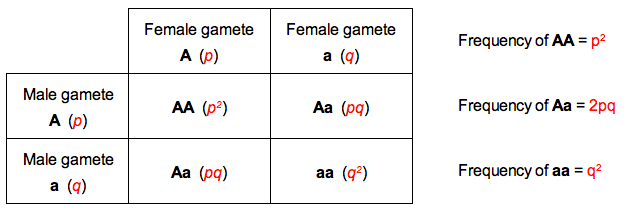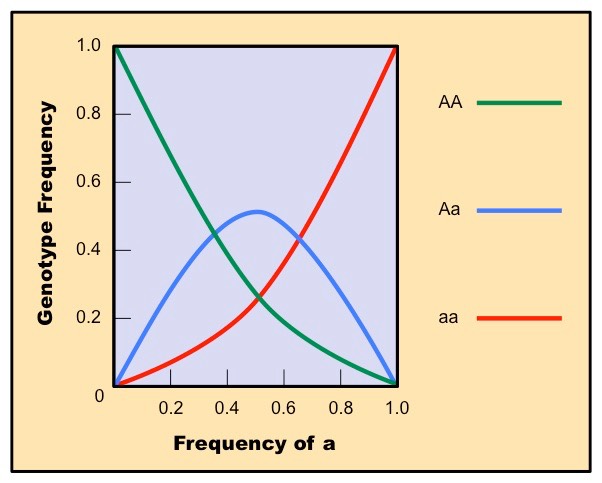D.4.1 Explain how the Hardy-Weinberg equation is derived
The Hardy-Weinberg equation predicts the frequency of two alternate alleles in a population
It is used for traits that show classical Mendelian inheritance:
- Only two alleles for a gene (one dominant and one recessive allele)
- Follows autosomal inheritance (not sex-linked traits)
For two alleles of a given genetic characteristic, three genotypes will exist: AA, Aa and aa
- Dominant allele is A, with a frequency of p
- Recessive allele is a, with a frequency of q
The total frequency of both alleles will be 1 (i.e. p + q = 1)
- Because genotype frequencies consist of two alleles, the equation must be squared: (p + q)2 = 1
This gives the expanded form of the Hardy-Weinberg equation: p2 + 2pq + q2 = 1
Deriving the Hardy-Weinberg Equation

D.4.2 Calculate allele, genotype and phenotype frequencies for two alleles of a gene, using the Hardy-Weinberg equation
Suppose we had a population of 500 individuals, in which 9% of individuals were albino (albinism is a recessive characteristic ð aa)
Using the equations: p + q = 1 and p2 + 2pq + q2 =1
• If q2 = 0.09 ð q = 0.3 (√0.9)
• If q = 0.3 ð p = 0.7 (p + 0.3 = 1)
• If p = 0.7 ð p2 = 0.49 (0.7 × 0.7)
• Therefore 2pq = 0.42 (2 × 0.7 × 0.3)
Substituting these numbers for frequencies and applying them to our original population, we find that:
- 49% are homozygous dominant (AA), which is 245 individuals (0.49 × 500)
- 42% are heterozygous (Aa), which is 210 individuals (0.42 × 500)
- 9% are homozygous recessive (aa), which is 45 individuals (0.09 × 500)
Representative Population ð Albinism Frequency = 9%

D.4.3 State the assumptions made when the Hardy-Weinberg equation is used
- When the Hardy-Weinberg equation is used in population genetics, it is assumed that a constant allele frequency will be maintained over time
- For this to occur it is implied that:
- The population is large
- There is random mating
- There is no mutation
- There is no gene flow (immigration or emigration)
- There is no natural selection or allele-specific mortality
Graphical Representation of the Hardy-Weinberg Equation
